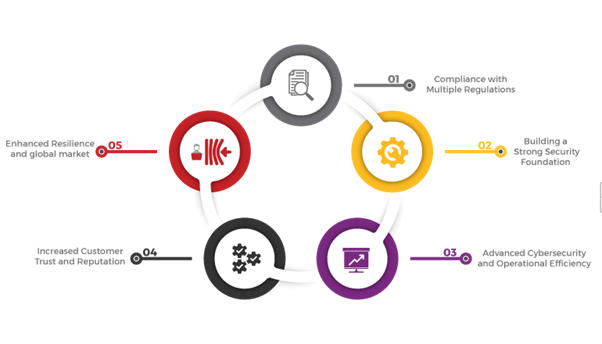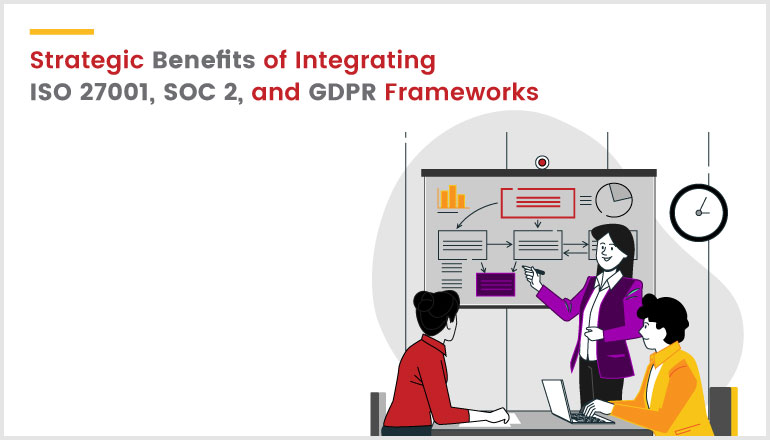Introduction
In today's dynamic digital era, organizations stand at the intersection of remarkable technological advancements, intense market competition, and ever-evolving cybersecurity threats. With technological advances, organizations can have opportunities for growth, innovation, and seamless service, which allows them to expand their operations and reach. At the same time, the rise of cybersecurity threats and relentless exploitation requires organizations to be vigilant and confront these challenges to ensure their security.
Implementing single security standards such as ISO 27001, GDPR, SOC 2, NIST Cybersecurity, PCI-DSS, and others establishes a common baseline for security practices, ensuring that organizations follow consistent approaches to safeguarding their digital and physical assets in various aspects. Certain areas might require specialized security measures that the single standard cannot fully address. This could result in unaddressed vulnerabilities or risks, falling short of complete compliance obligations, and leading to over- or under-securing certain areas. If the organization's structure or systems are highly complex, implementing a single standard might be challenging and could lead to overlooking important security aspects.
To navigate complexity, organizations need a proactive and comprehensive security approach. Integrating multiple security standards is a powerful solution to strengthen defenses. Through integration, organizations can position themselves as leaders in security and instill trust among their stakeholders.
In this blog, we explore the top five advantages of integrating multiple security standards, which empower organizations to face the evolving challenges of the cyber world with confidence.

Compliance with Multiple Regulations
Many industries are subject to multiple regulations and compliance requirements. Integrating multiple security standards provides the benefit of meeting various regulatory frameworks simultaneously. Instead of tackling compliance separately for each standard, organizations can simplify their efforts by identifying commonalities and overlaps, reducing duplication of work, streamlining audit processes, and ensuring consistent adherence to regulatory requirements. This also minimizes the risk of non-compliance and associated penalties or reputational damage.
Through the integration of multiple standards, organizations signal to their stakeholders that they adhere to globally recognized security frameworks and follow industry-leading best practices.
Building a Strong Security Foundation
Integrating multiple security standards strengthens an organization's security posture by implementing a robust and layered defense system across multiple dimensions. This approach surpasses compliance by proactively identifying and mitigating security risks, fostering consistency in security measures, handling data with the utmost care, promoting a culture of awareness, and reducing successful attacks through unified incident management techniques.
By combining controls, best practices, and technologies from different standards, organizations create a comprehensive framework that addresses a broader range of threats, minimizes vulnerabilities, mitigates potential damages, and enhances their overall security posture across the organization.
Advanced Cybersecurity and Operational Efficiency
Integrating multiple security standards enhances organization cybersecurity by achieving increased adaptability, scalability, cost optimization, and reduced complexity. Technology advancements and changing threat landscapes constantly introduce new security challenges. This adaptability ensures that organizations can respond effectively to new regulations, evolving business needs, and emerging security risks. It also facilitates scalability, allowing organizations to expand their operations without compromising security.
Increased Customer Trust and Reputation
Today, data security and privacy are paramount concerns for customers. Integrating multiple security standards enhances customer trust and confidence in an organization's ability to protect their sensitive information. This commitment reassures customers that their data is protected using industry-leading practices and technologies. When customers trust an organization's security measures, they are more inclined to do business, share information, and maintain long-term relationships.
This fosters greater customer loyalty and a positive brand and reputation. Additionally, this commitment increases confidence in customers, partners, and investors, enhancing trustworthiness, attracting new clients, and winning contracts.
Enhanced Resilience and global market
Resilience allows organizations to maintain business continuity, protect critical assets, and minimize the impact of security incidents on operations and reputation.
Also, integration enables organizations to meet the security requirements of global expansion, which facilitates market access to different countries or regions that mandate specific security standards. It also streamlines the process of entering new markets and opens up international business opportunities that ensure future-proofing through the long-term security and sustainability of the business.
Experiential Showcase of BriskInfosec
In the dynamic world of digital services, one of our clients, a prominent SaaS player with a robust customer base across the US and EU regions, faced the dual challenge of ensuring high-security standards and complying with ISO 27001, SOC 2, and GDPR regulations. Recognizing the need for an effective solution, the client joined forces with Briskinfosec to integrate these diverse compliance frameworks. This strategic move resulted in streamlined operations, significant cost savings, and strengthened credibility. By adopting a comprehensive approach, our client strengthened its customer relationships and gained a competitive edge in expanding its business reach.

The collaboration between our Client and Briskinfosec is a powerful testament to the transformative potential of integrated compliance. It demonstrates how a unified strategy can reshape a company's compliance landscape and enable it to thrive in today's competitive market.
Conclusion
In conclusion, integrating multiple security standards gives organizations a powerful advantage in the ever-changing digital world. By embracing integration, organizations can proactively address emerging security challenges, establish a resilient security foundation that adapts to future demands, and demonstrate a commitment to best practices, setting them apart in an increasingly security-conscious environment.
We, BriskInfosec are a leading expert in information security, dedicated to protecting sensitive data and clients from cyber threats. Their use of internationally recognized standards ensures strong security measures, instilling confidence in stakeholders. Their seamless integration of these standards creates an efficient and effective security framework.


